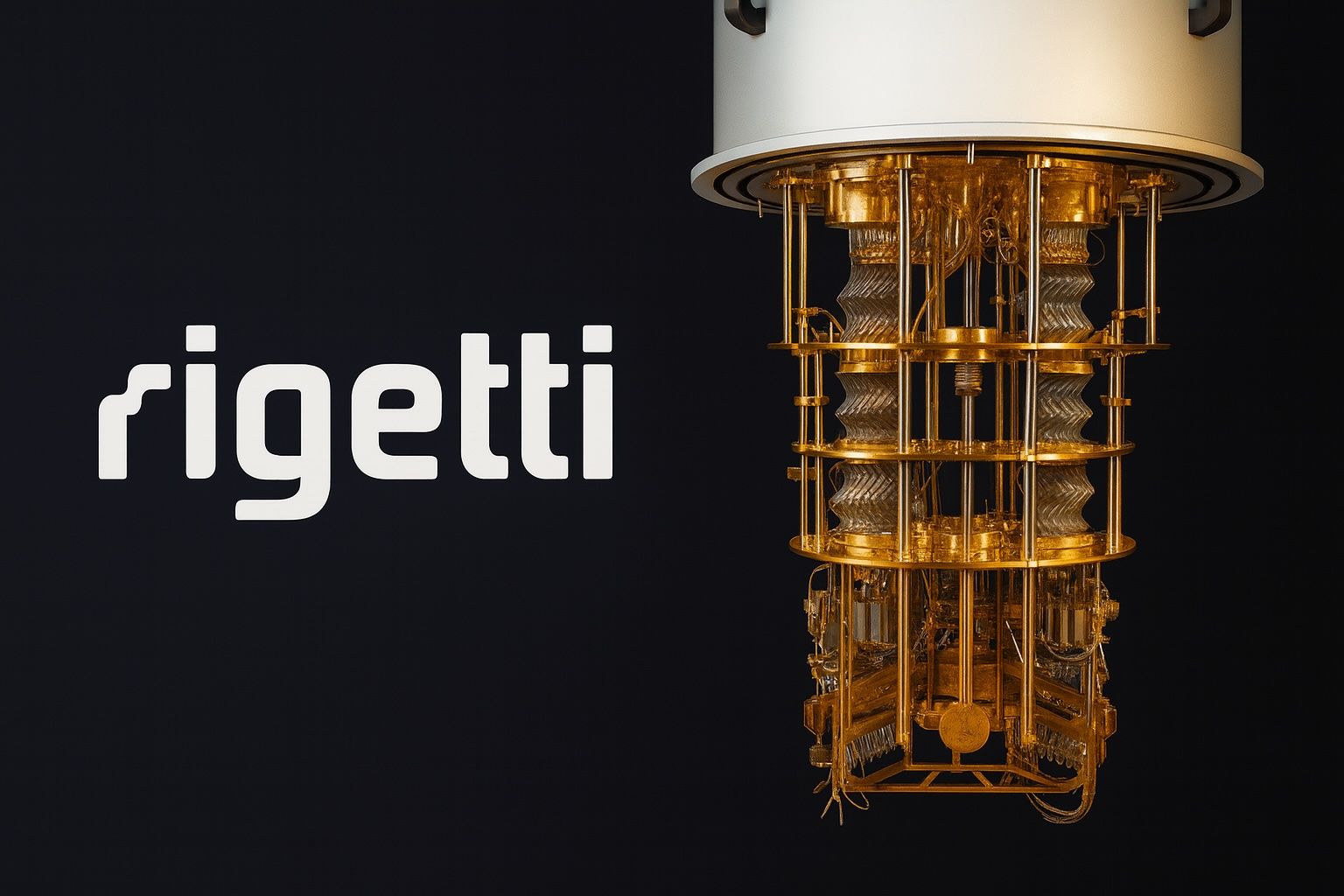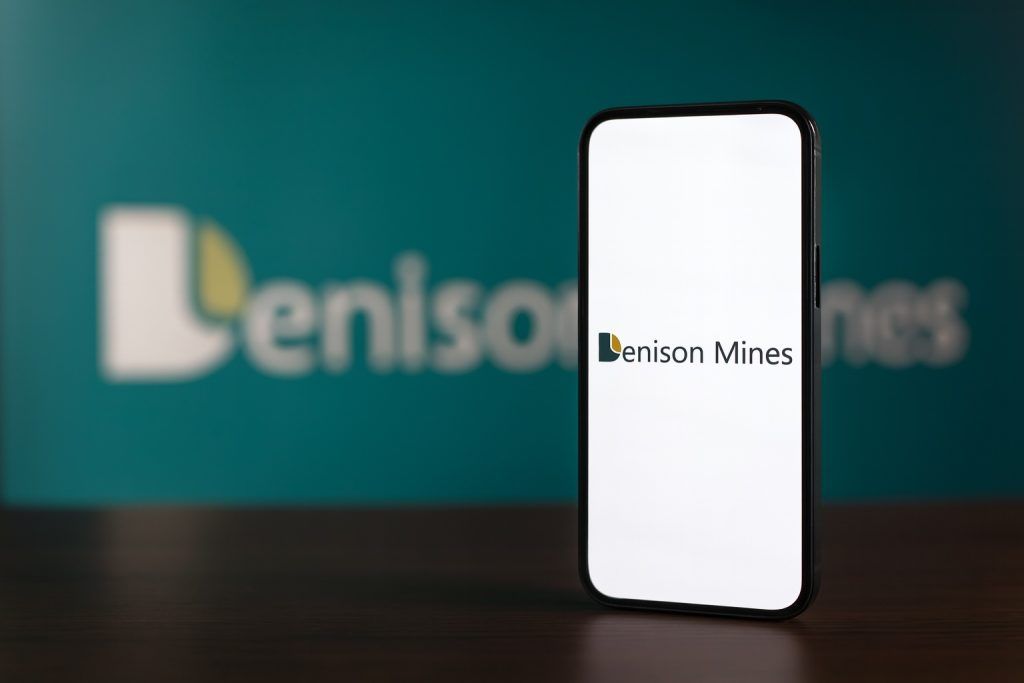- Record Surge: Rigetti Computing (NASDAQ: RGTI) stock hit an all-time high around $56 this week after spiking 25% in a single day on Oct. 13 [1]. Shares have now risen over 5,000% in the past year [2], massively outpacing the broader market.
- Big Deals & Tech Wins: The quantum computing upstart has fueled investor excitement with new contracts and innovations. Rigetti secured about $21 million in recent deals – including a $5.8 M U.S. Air Force contract and $5.7 M in orders for its Novera quantum computers [3] – and launched a cutting-edge 36-qubit quantum processor available via the cloud [4].
- Sky-High Valuation: Despite a market cap near $17 billion, Rigetti’s annual revenue is only ~$8–10 million and it remains deeply unprofitable [5] [6]. The stock trades at 1,500×+ sales, far above industry norms [7], raising concerns that its valuation has vastly outrun fundamentals [8].
- Analyst Sentiment: Every Wall Street analyst covering Rigetti rates it a “Buy,” reflecting optimism about its long-term potential. However, their average 12-month price targets (mostly in the $20–$30 range) sit roughly 50% below the current share price [9]. Some experts warn the quantum computing boom may be a bubble, predicting a sharp pullback ahead [10] [11].
- Technical Red Flags: Rigetti’s stock chart shows extreme momentum and overbought signals. The share price is far above its 50-day (~$25) and 200-day (~$15) moving averages [12], and its RSI momentum indicator is ~85 (well above the 70 threshold), indicating overbought conditions [13]. Indeed, after a parabolic rise, the stock pulled back about 13% toward $50 on Oct. 16 amid profit-taking and news of insider selling [14].
Stock Price Skyrockets to Record High
Rigetti Computing’s stock has exploded in 2025, reaching new highs as investors bet big on quantum computing.
Rigetti’s share price has soared exponentially this year, reflecting frenzy around pure-play quantum computing stocks. At the start of 2025, RGTI traded under $1; by mid-October it rocketed into the mid-$50s, marking a +259% year-to-date gain and roughly 50-fold increase from a year ago [15]. The stock closed at a record $56.34 on October 15, 2025 [16] – its highest ever – before settling just below that level. In the span of a few trading days, Rigetti jumped from the mid-$40s to mid-$50s: on Oct. 13 alone, it surged ~25% to $54.91 at close [17], and it notched another all-time closing high the following day. This rally has propelled Rigetti’s market capitalization to an eye-popping $16–18 billion range [18], astounding for a company with only single-digit millions in revenue. For context, other quantum computing stocks have also skyrocketed in 2025 – IonQ is up ~700% year-over-year and D-Wave >2,000% [19] – as investors pile into the sector’s promise.
However, the froth began showing cracks by October 16. Rigetti’s stock slid about 13% intraday that Thursday, dipping to the high-$40s [20]. The pullback came amid a broader cooling of the quantum computing “melt-up” and some company-specific jitters. Notably, reports emerged that CEO Subodh Kulkarni had sold his entire 1,000,000-share stake earlier in the year, leaving him with no shares [21]. This insider sale news, coupled with natural profit-taking after such a torrid run, gave investors pause. Even after the dip, RGTI stock is up over 5,000% year-on-year [22] and sits in a 52-week range of roughly $0.80 to $58.15 [23] – a stunning trajectory that underlines both the euphoria and the volatility surrounding quantum computing names.
Several catalysts have fueled Rigetti’s parabolic ascent. A major spark came in mid-October when JPMorgan Chase announced a sweeping $10 billion “Security and Resiliency” tech initiative that explicitly highlighted quantum computing as a key area for investment [24]. This signal of institutional commitment to quantum tech ignited a sector-wide surge, with Rigetti leading the pack. Additionally, public interest in quantum computing spiked after the 2025 Nobel Prize in Physics recognized pioneering work in quantum information science, adding to the sense that the field’s moment has arrived [25]. In short, Rigetti’s stock has been swept up in a perfect storm of hype, hope, and momentum trading, sending its value to stratospheric heights in a matter of months.
Big Deals, Partnerships & Tech Milestones
Rigetti’s fundamental story has evolved rapidly through high-profile deals and R&D breakthroughs in recent months. In late September, the company announced two significant contract wins that validated its technology – and sent its stock even higher. It secured a $5.8 million contract from the U.S. Air Force Research Lab (AFRL) (in collaboration with Dutch startup QphoX) to develop superconducting quantum networks [26]. Around the same time, Rigetti received $5.7 million in purchase orders for two of its new “Novera” on-premises quantum computers (small 9-qubit systems) from unnamed customers [27]. For a company that only made about $10 M in revenue all of last year, each of these deals is huge – on the order of 70–80% of Rigetti’s annual sales – and indeed the stock jumped double digits (11–19%) on the news of these wins [28]. While modest in absolute terms, the contracts lend credibility by showing that real paying customers (including the U.S. government) are investing in Rigetti’s technology.
On the technology front, Rigetti achieved a major milestone in August 2025 by unveiling its latest quantum processor, dubbed “Cepheus-1”. This is a 36-qubit quantum processing unit built with a novel multi-chip architecture – essentially four linked superconducting chips working together [29]. The new design dramatically boosted Rigetti’s computing firepower, quadrupling the chiplet count from its previous-generation 9-qubit devices and cutting error rates in half (achieving ~99.5% two-qubit fidelity) [30]. In practical terms, Cepheus-1 roughly doubled Rigetti’s prior performance benchmarks and represents a meaningful step toward more scalable quantum computers. The Cepheus-36Q system was made generally available (GA) on Rigetti’s Quantum Cloud Services platform in Q3, and is also offered through Microsoft’s Azure Quantum cloud, expanding its reach to enterprise and research users [31]. Rigetti’s CEO Dr. Subodh Kulkarni emphasized that “quadrupling our chiplet count and significantly decreasing error rates is the clear path towards quantum advantage and fault tolerance,” underscoring the strategic importance of this R&D breakthrough [32].
Rigetti has also been busy building partnerships and global collaborations to bolster its ecosystem. Notably, Taiwan’s Quanta Computer – a major electronics manufacturer – made a $35 million strategic investment in Rigetti in 2025 as part of a broader collaboration exceeding $100 M to help Rigetti scale up its hardware production [33]. In addition, Rigetti inked a memorandum of understanding with India’s C-DAC (Centre for Development of Advanced Computing) in September to co-develop hybrid quantum-classical computing initiatives [34]. This could pave the way for Rigetti’s expansion into the fast-growing Indian tech market. Closer to home, Rigetti delivered its first on-premises Novera quantum system to Montana State University in August [35], where it will be used in a new quantum research center – a milestone first deployment in an academic setting. Furthermore, Rigetti announced a partnership with NVIDIA to enhance its quantum computing capabilities with NVIDIA’s GPUs and software, a move aimed at integrating quantum and classical computing for better performance [36]. All of these strategic moves – from government contracts and university installations to industry alliances – expand Rigetti’s credibility and footprint in the nascent quantum computing field. They also signal to investors that Rigetti is positioning itself as a key player through real-world engagements, not just laboratory experiments.
Financials and Earnings Outlook
Despite the stock market enthusiasm, Rigetti’s financial results reveal a company still in the early stages of commercialization, with minimal revenue and significant losses. In Q2 2025, Rigetti reported revenue of just $1.8 million, a 42% drop from the ~$3 million in the same quarter a year prior [37]. The company’s net loss for Q2 was a hefty $39.7 million [38], reflecting heavy R&D and operating expenses as Rigetti races to develop its technology. For the full year 2024, Rigetti generated only $10.8 million in revenue while incurring a net loss of about $201 million [39] – a stark illustration of the “cash burn” common among early-stage tech firms. Gross margins have been under pressure as well (31% in Q2 vs 64% a year earlier) [40]. These fundamentals explain why traditional valuation metrics like P/E are meaningless (Rigetti has no earnings), and even its price-to-sales ratio has ballooned into the thousands [41]. Indeed, as noted, Rigetti’s market value of ~$17 B is over 1,500× its annual sales – a ratio virtually unheard of outside of speculative bubbles [42].
The good news is that Rigetti has shored up its balance sheet to fund its ambitions (and ongoing losses). In mid-2025, the company took advantage of its surging stock price to raise capital: it conducted a large at-the-market (ATM) equity offering, bringing in roughly $350 million in new cash during Q2 [43]. As a result, Rigetti ended the second quarter with approximately $571.6 million in cash and no debt [44] – a healthy war chest that provides runway for further R&D and operations. This cash cushion is critical, as quantum hardware development is expensive and profitability remains far off. With nearly half a billion dollars on hand, Rigetti has the resources to keep innovating (and can better weather any market volatility). However, the fundraising came at the cost of substantial dilution to existing shareholders, nearly quadrupling Rigetti’s outstanding share count in the past year – something to keep in mind when evaluating its market cap versus underlying value.
Looking ahead, investors are anxious to see if Rigetti’s technical progress will start translating into revenue growth. The company’s next earnings report (Q3 2025) is expected in mid-November. Analysts forecast another quarterly loss (consensus -$0.05 EPS), but an incremental uptick in revenue to around $2.4 million [45]. That would be essentially flat (+0.4%) compared to the $2.39 M in Q3 2024 [46] – hardly a breakthrough, but at least stemming the decline seen in Q2. Any guidance on new bookings or increased usage of Rigetti’s cloud quantum services will be closely watched. Wall Street’s 2025 full-year estimates remain modest: around ~$8–9 M in revenue (versus $8.2 M in 2024) and continued net losses, with a hope that sales could ramp up to ~$20+ M by 2026 as recent deals kick in [47]. In short, near-term financial expectations are low – investors in Rigetti are betting on the long-term payoff of quantum computing rather than current earnings. As Zacks Equity Research noted, for companies like Rigetti, 2025 is about “steady engineering advances” and strategic progress, since meaningful profits are likely years away [48] [49].
Analyst Ratings and Stock Forecasts
Wall Street analysts covering Rigetti remain optimistic about the company’s technology and future prospects, but they also acknowledge the disconnect between the stock price and fundamentals. According to TipRanks and other tracking services, all 6 of the analysts with coverage on RGTI rate it either a Buy or Strong Buy, reflecting a broadly bullish outlook [50]. Firms like Benchmark and B. Riley, for example, have praised Rigetti’s rapid technical advancements – Benchmark Capital even raised its price target to $50 (Buy) on October 7, 2025 [51], and B. Riley upped its target to $35 (Buy) around the same time [52]. However, most other analysts have far more conservative targets in the teens or low-$20s [53]. The consensus 12-month price target for Rigetti sits in the mid-$20s, which is roughly 50% below the recent trading range in the $50s [54]. In other words, even the bulls on Wall Street feel the stock has gotten ahead of itself. MarketBeat reports a similar analyst consensus rating of “Moderate Buy” with an average target around $28, implying significant downside from current levels [55].
This dichotomy – strong buy ratings but low price targets – highlights how analysts view Rigetti: they believe in the long-term growth story of quantum computing, yet see the near-term valuation as stretched. One analyst candidly noted that Rigetti’s current market cap (>$10B) is built on “tremendous growth assumptions,” while “the shift to commercial quantum… hasn’t happened yet” in any substantial way [56]. In reports, analysts frequently stress the risks: the company has to execute flawlessly on its roadmap (e.g. delivering a 100+ qubit system by 2025’s end as promised [57]) and prove that quantum computing can solve real-world problems faster or cheaper than classical computing. Until then, price targets remain anchored low. For instance, Needham’s latest target is only $18 [58], and Cantor Fitzgerald’s is in the low-$20s [59], both well under the current price. The outliers like Benchmark’s $50 target essentially see the stock as fully valued even under bullish scenarios. To justify further upside, Rigetti will eventually need to show revenue traction and a path toward monetizing its breakthroughs. For now, analysts’ positive ratings indicate they don’t want clients to miss out on a potentially transformative winner, but their cautious targets suggest they also anticipate a correction or a long plateau while the fundamentals catch up.
Technical Analysis: Chart Trends and Volatility
From a technical analysis perspective, Rigetti’s stock has been in a steep uptrend but is now exhibiting signs of overextension. The rally blasted the share price well above key trend indicators. Rigetti is trading far above its moving averages – as of this week, the stock was over 100% higher than its 50-day average (~$25) and nearly 4× its 200-day average (~$15) [60]. This reflects a powerful momentum surge, but also a level of separation that often isn’t sustainable without pauses. Momentum indicators confirm the overbought condition: Rigetti’s 14-day Relative Strength Index (RSI) recently hit 85+ [61], which is extremely high. (Typically, an RSI above 70 suggests a stock may be overbought and due for consolidation or a pullback.) Other short-term gauges like the Moving Average Convergence Divergence (MACD) are strongly positive, consistent with the bullish trend [62]. Additionally, trading volume spiked during the advance (Rigetti traded 100–180 million shares on big up days vs. ~68 million average) [63], a sign of euphoric buying that can sometimes mark a near-term climax.
The stock’s volatility has also jumped alongside its price. The Average True Range (ATR), a measure of daily price swings, is around $7–8 per day – roughly 14% of the stock’s price at ~$55 [64]. Such wide swings indicate that Rigetti can move $5–10 in a single session, a double-edged sword for traders. Key technical levels have emerged from this volatile action. On the downside, the $47–50 region appears to be an initial support zone – that’s roughly where Rigetti stock found a floor after its Oct. 16 pullback, and coincides with an intraday low of $47.11 earlier in the week [65]. If the stock were to break below ~$47, technicians warn of a possibility of a deeper retracement (for example, the next support might be around the mid-$30s, which was the early September level [66]). On the upside, with the stock in uncharted territory, there isn’t much historical resistance to pinpoint; traders are eyeing the recent peak near $58 as a psychological resistance level in the short term [67]. Notably, $55–58 was an area where the stock struggled to hold its intraday highs, suggesting buyers may be hesitant above the mid-$50s for now.
Given these technical factors, many analysts are advising caution for the near term. Overbought readings like the RSI in the mid-80s often precede either a period of consolidation (sideways/choppy trading) or a sharper corrective dip. In Rigetti’s case, we’ve already seen a quick double-digit drop from the top – the stock went from ~$58 down to ~$49 (-15%) within a couple of days [68]. This kind of whipsaw is emblematic of a stock that went up very far, very fast. Short-term forecasts now suggest Rigetti could trade in a volatile range rather than continue straight up. For example, one technical analysis on StockInvest.us projected choppy trading between roughly $47 (support) and $56 (resistance) over the coming days, with a bias toward testing the lower end of that range [69] [70]. In summary, the technical outlook is bullish but stretched – Rigetti’s trend is still upward, yet the risk of a pullback or increased volatility is high after its parabolic run. Traders and investors may want to keep an eye on whether the stock can hold above key support levels in the high-$40s and whether momentum indicators cool off, as signals for when (or if) this quantum-fueled rocket might stabilize.
Expert Opinions & Industry Outlook
Rigetti’s astonishing rise has divided market commentators on the question: is this the birth of a new tech revolution, or the makings of a bubble? On one hand, quantum computing is widely seen as transformative – potentially solving complex problems far beyond the reach of today’s computers. A Bank of America strategist recently called it “the most important technological race of our generation,” highlighting why so many investors don’t want to miss out [71]. Bulls point to forecasts like a McKinsey study projecting the quantum computing market could grow from about $1 billion today to $70+ billion by 2035 [72]. If those predictions pan out, early leaders like Rigetti (with its own quantum fab and full-stack expertise) could eventually justify their hefty valuations. Even TV personality and stock picker Jim Cramer – who has been skeptical – concedes that “quantum computing is for real” and that Rigetti “could have something that’s a home run” if its technology advances, but he stresses “it is a speculation, please remember that” [73]. In fact, Cramer has openly called Rigetti “pure speculation”, admitting “I don’t know whether [the company] is worth what it’s trading at” [74]. This encapsulates the mixed sentiment: there is tremendous future potential, but also a recognition that the current hype may be sprinting ahead of reality.
Many analysts and financial writers have issued bubble warnings regarding Rigetti and its quantum peers. Barron’s, the investment publication, noted that a basket of quantum stocks (Rigetti, IonQ, D-Wave, etc.) had surged nearly 4× in a year “even though they generate relatively little revenue,” cautioning that this “bubble may keep inflating until it is tested by fundamentals.” [75] Morgan Stanley’s tech analyst Joseph Moore recently predicted that Rigetti (and IonQ) could fall up to ~60% if investor sentiment toward the sector shifts or disappointing news emerges [76]. The concern is that much of Rigetti’s valuation is based on assumptions of future breakthroughs rather than anything tangible today – a classic hallmark of speculative manias. Short-seller communities and skeptics point out that insiders have been cashing out: along with the CEO’s sale, multiple Rigetti directors unloaded millions of dollars worth of shares during the stock’s epic rise [77]. The lack of insider ownership going forward is seen as a red flag by some, casting doubt on management’s true confidence (by contrast, founders of some other tech companies maintained large stakes through early growth phases). Furthermore, renowned investor Jeremy Grantham has commented on bubbles saying that during “exponential phases” of new technologies, markets often over-discount the challenges – something to beware of in quantum computing where technical hurdles to practical use (error correction, scalability) are still significant.
Still, it’s not all cautionary tales – plenty of experts remain excited about Rigetti’s prospects. Supporters compare the company’s strategy to that of Palantir in its early days: focusing on big government contracts and partnerships (like with the U.S. Air Force, defense labs, etc.) to develop cutting-edge tech with guaranteed funding [78] [79]. If Rigetti can become an indispensable provider of quantum solutions to government agencies (for encryption, optimization, etc.), it could mirror Palantir’s path of turning R&D contracts into a springboard for commercial products down the road. Additionally, tech analysts note that Rigetti’s partnership with industry giants (e.g. Microsoft, Nvidia, and Quanta) gives it validation and support that most small-cap companies lack [80]. The broader adoption of quantum cloud services by players like Azure could funnel more enterprise users to Rigetti’s platform over time. In essence, the bull case is that Rigetti is one of a handful of pioneers in a field that could revolutionize computing – so owning a piece of it now, though risky, might yield massive rewards if quantum computing reaches its potential.
The bottom line: Rigetti Computing’s stock has delivered a stunning ride, encapsulating the market’s thrill for a breakthrough technology as well as the peril of speculative excess. The company’s recent contracts and technical strides show real progress and have stoked justifiable optimism about its trajectory in the quantum “space race.” At the same time, the disconnect between Rigetti’s tiny revenues and its towering valuation has grown ever more extreme, prompting seasoned observers to urge caution. As one finance columnist quipped, this quantum bubble “may keep inflating until it is tested by fundamentals.” [81] In the coming months, investors will be watching for those fundamentals – from Rigetti’s earnings report to any new deals or tech milestones – to gauge whether the company can begin to grow into its valuation. For now, RGTI remains a high-flying “moonshot” stock, balancing incredible upside potential against equally outsized risk. In an arena as cutting-edge as quantum computing, hype and hope tend to arrive far sooner than profits – and Rigetti’s wild 2025 ride is a vivid reminder of both.
Sources: Rigetti & Co. press releases; Tokenist/WRAL TechWire [82] [83]; TechStock² (ts2.tech) reports [84] [85]; Zacks Equity Research [86]; TradingView/GuruFocus [87] [88]; Benzinga News [89] [90]; StockInvest.us analysis [91] [92]; CNBC/InsiderMonkey (Jim Cramer comments) [93]; Barron’s via TipRanks [94].
References
1. ts2.tech, 2. markets.financialcontent.com, 3. markets.financialcontent.com, 4. markets.financialcontent.com, 5. www.tradingview.com, 6. ts2.tech, 7. www.tradingview.com, 8. www.tradingview.com, 9. ts2.tech, 10. ts2.tech, 11. www.tradingview.com, 12. www.benzinga.com, 13. www.benzinga.com, 14. www.benzinga.com, 15. markets.financialcontent.com, 16. www.macrotrends.net, 17. stockinvest.us, 18. stockinvest.us, 19. ts2.tech, 20. www.benzinga.com, 21. www.benzinga.com, 22. markets.financialcontent.com, 23. www.benzinga.com, 24. markets.financialcontent.com, 25. markets.financialcontent.com, 26. investors.rigetti.com, 27. ts2.tech, 28. ts2.tech, 29. ts2.tech, 30. ts2.tech, 31. ts2.tech, 32. ts2.tech, 33. ts2.tech, 34. ts2.tech, 35. ts2.tech, 36. markets.financialcontent.com, 37. www.tradingview.com, 38. ts2.tech, 39. ts2.tech, 40. ts2.tech, 41. www.tradingview.com, 42. www.tradingview.com, 43. ts2.tech, 44. ts2.tech, 45. performance-test.zacks.com, 46. performance-test.zacks.com, 47. ts2.tech, 48. performance-test.zacks.com, 49. performance-test.zacks.com, 50. ts2.tech, 51. ts2.tech, 52. ts2.tech, 53. ts2.tech, 54. ts2.tech, 55. www.gurufocus.com, 56. ts2.tech, 57. ts2.tech, 58. ts2.tech, 59. ts2.tech, 60. www.benzinga.com, 61. www.benzinga.com, 62. stockinvest.us, 63. stockinvest.us, 64. stockinvest.us, 65. stockinvest.us, 66. www.tradingview.com, 67. stockinvest.us, 68. www.benzinga.com, 69. stockinvest.us, 70. stockinvest.us, 71. ts2.tech, 72. ts2.tech, 73. finance.yahoo.com, 74. ts2.tech, 75. ts2.tech, 76. ts2.tech, 77. ts2.tech, 78. www.benzinga.com, 79. www.benzinga.com, 80. markets.financialcontent.com, 81. ts2.tech, 82. markets.financialcontent.com, 83. markets.financialcontent.com, 84. ts2.tech, 85. ts2.tech, 86. performance-test.zacks.com, 87. www.tradingview.com, 88. www.tradingview.com, 89. www.benzinga.com, 90. www.benzinga.com, 91. stockinvest.us, 92. stockinvest.us, 93. ts2.tech, 94. ts2.tech






